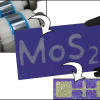| Jun 29, 2023 |
|
|
|
(Nanowerk Spotlight) A team of researchers from the Materials Science Factory at the Instituto de Ciencia de Materiales de Madrid (ICMM-CSIC) has developed a groundbreaking method for high-throughput mechanical exfoliation, enabling low-cost production of van der Waals nanosheets.
|
|
The technique, presented in their recent publication in Small Methods (“High-Throughput Mechanical Exfoliation for Low-Cost Production of van der Waals Nanosheets”), offers a significant advancement in the scalable fabrication of low-cost devices while maintaining excellent performance.
|
 |
| Composite image showing the roll-to-roll like setup to perform the high throughput mechanical exfoliation, an example of a film composed by exfoliated flakes deposited on a SiO2/Si chip and a field-effect transistor device fabricated out of one of these films. (Image courtesy of the researchers)
|
|
Mechanical exfoliation, the process of isolating two-dimensional (2D) materials from their bulk counterparts, has long been recognized for its ability to produce materials of exceptional quality. However, the lack of control over thickness and lateral size, as well as the difficulty of scaling up the process, have posed significant challenges. Previous attempts to address these limitations either required complex transfer techniques or were incompatible with certain van der Waals materials.
|
|
In their study, the research team developed an automatized, massive parallel exfoliation process using a roll-to-roll setup. This innovative approach allows for the production of adhesive tapes with a high density of nanosheets, achieving a balance between large lateral size and excellent area scalability, all while maintaining low cost.
|
 |
| Video showing the process to exfoliate the van der Waals materials. (Courtesy of the researchers)
|
|
The versatility of this production method extends to a wide range of substrates and van der Waals materials, making it a promising avenue for the combination of different 2D materials. By adhering these tapes to an acceptor surface and subjecting them to a gentle annealing process, the majority of the material can be effectively transferred. The researchers successfully demonstrated the potential of this technique by fabricating field-effect transistors and flexible photodetectors in large batches.
|
|
“The development of our high-throughput mechanical exfoliation technique opens up exciting possibilities for the fabrication of low-cost devices,” said Dr. Andres Castellanos-Gomez. “With this method, we have achieved a remarkable trade-off between cost, scalability, and performance, paving the way for widespread application of van der Waals nanosheets in various fields.”
|
 |
| Video showing the process of transferring the exfoliated nanosheets from the adhesive tape to an arbitrary substrate. (Courtesy of the researchers)
|
|
The novel method presents a significant improvement over existing approaches. While chemical vapor deposition (CVD) and liquid phase exfoliation (LPE) offer scalability and cost advantages, they often compromise control over thickness, lateral size, or electrical properties. In contrast, the newly developed technique combines low cost, all-dry process even compatible with air-sensitive materials, excellent scalability, and large lateral sizes, ensuring the production of 2D materials with superior electrical properties.
|
|
The breakthrough achieved by the team at ICMM-CSIC has garnered considerable attention from the scientific community. It is poised to revolutionize the applications requiring low-cost films composed of 2D materials like smart coatings and biosensors.
|
|
Provided by the Instituto de Ciencia de los Materiales de Madrid
|
|
|




